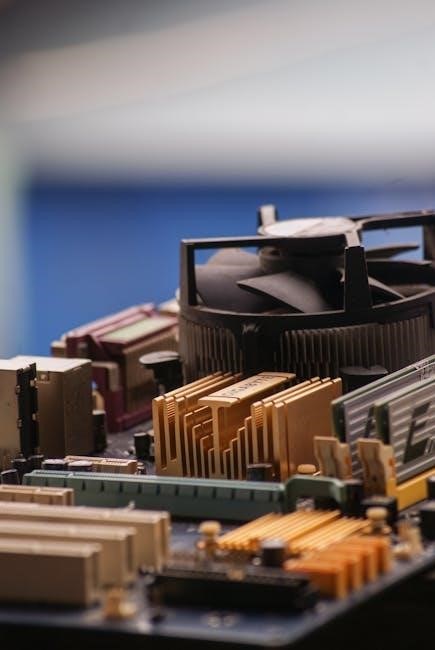Stihl FS 56 RC Parts Diagram PDF: A Comprehensive Guide
This guide provides a comprehensive overview of the Stihl FS 56 RC parts diagram PDF. It offers resources for identifying components, accessing diagrams, and ensuring safety. Use exploded views to pinpoint trimmer parts and find correct parts lists for your Stihl FS 56 RC.

Overview of Stihl FS 56 RC Trimmer
The Stihl FS 56 RC trimmer is a versatile tool designed for tackling tough grass and maintaining your yard with ease. As a popular model in the Stihl lineup, it offers a balance of power and user-friendly features, making it suitable for both homeowners and landscaping professionals. Understanding the components of your FS 56 RC trimmer is crucial for proper maintenance and repairs. This is where the parts diagram becomes invaluable.
The FS 56 RC is known for its reliable performance and durable construction. However, like any mechanical device, parts can wear down or become damaged over time. Having access to a detailed parts diagram allows you to identify the exact components you need for repairs, ensuring that you can keep your trimmer running smoothly for years to come.
Whether you’re replacing a worn-out air filter, fixing a carburetor issue, or addressing a problem with the rewind starter, the parts diagram serves as your go-to reference. It provides a visual representation of the trimmer’s assembly, making it easier to locate and order the correct replacement parts. With the right knowledge and resources, you can confidently maintain your Stihl FS 56 RC trimmer and keep your yard looking its best.
Accessing Stihl FS 56 RC Parts Diagrams
Finding the correct parts diagram for your Stihl FS 56 RC trimmer is essential for accurate repairs and maintenance. Fortunately, several resources are available to help you locate and access these diagrams. One of the most reliable sources is the official Stihl website, where you can often find parts diagrams and manuals specific to your model.
Another option is to search online for “Stihl FS 56 RC parts diagram PDF.” Numerous websites and online retailers offer downloadable parts diagrams for various Stihl models. When searching, be sure to specify the exact model number (FS 56 RC) to ensure that you obtain the correct diagram for your trimmer.

In addition to online resources, you can also consult your local Stihl dealer. They can provide you with a physical copy of the parts diagram or assist you in finding the correct diagram online. Your dealer can also offer expert advice on identifying parts and performing repairs. Remember to cross-reference diagrams with your owner’s manual. Always verify the diagram’s compatibility with your specific FS 56 RC model before ordering any parts.
Using Parts Diagrams for Identification
Once you have accessed the Stihl FS 56 RC parts diagram, the next step is to effectively use it for identifying the components you need. The diagrams typically feature an exploded view, which presents each part individually and shows how they fit together. This visual representation is invaluable for understanding the trimmer’s assembly and locating specific parts.
Each part in the diagram is labeled with a unique number. These numbers correspond to a parts list, which is usually included with the diagram. The parts list provides detailed information about each component, including its name, description, and Stihl part number. To identify a part, first locate it on the diagram, note its number, and then find the corresponding entry in the parts list.
Pay close attention to the diagram’s details, such as the shape, size, and orientation of each part. Compare these details with the actual part you are trying to identify. If you are unsure about a particular part, consult with a Stihl dealer or experienced repair technician. Using the parts diagram accurately is crucial for ordering the correct replacement parts and ensuring that your Stihl FS 56 RC trimmer is repaired properly.
Common Parts Found in Stihl FS 56 RC Diagrams
Stihl FS 56 RC parts diagrams commonly feature several key components essential for the trimmer’s operation. Among these, the carburetor is a vital part, responsible for mixing air and fuel for combustion. Diagrams detail its various parts, including jets, needles, and floats.

The rewind starter mechanism is another frequently referenced section. It includes components like the starter rope, pulley, spring, and pawls, all working together to initiate the engine. The crankcase and cylinder assembly are also prominently featured, showing the piston, cylinder, crankshaft, and connecting rod.
The air filter is another common component highlighted in the diagrams. It protects the engine by preventing debris from entering. Diagrams illustrate the air filter’s location, shape, and how it is connected to the carburetor.
Other parts frequently found in Stihl FS 56 RC diagrams include the fuel tank, fuel lines, spark plug, muffler, and various screws, bolts, and washers. These diagrams are crucial for identifying and replacing worn or damaged parts, ensuring the trimmer’s optimal performance and longevity.
Carburetor Parts Diagram Details

The carburetor parts diagram for the Stihl FS 56 RC provides a detailed breakdown of this critical engine component. These diagrams typically illustrate the carburetor’s individual parts, including the fuel inlet needle, main jet, pilot jet, and various adjustment screws. Understanding the relationship between these parts is essential for proper carburetor function.
The diagram often shows the float bowl and its associated float, which regulates the fuel level within the carburetor. It also details the throttle valve and choke valve, which control air and fuel flow into the engine. The diagram may also include o-rings, gaskets, and other small parts that ensure a tight seal and prevent fuel leaks.
A close examination of the carburetor parts diagram can help users identify specific components that may be causing issues, such as a clogged jet or a worn-out needle valve. By referencing the diagram, users can accurately order replacement parts and properly reassemble the carburetor after cleaning or repair.

Furthermore, the diagram can assist in understanding the carburetor’s adjustment points, allowing users to fine-tune the fuel-air mixture for optimal engine performance. These diagrams are indispensable for anyone working on the Stihl FS 56 RC carburetor.
Rewind Starter Diagram and Components
The rewind starter diagram for the Stihl FS 56 RC provides a detailed visual representation of all the components within the starter assembly. This diagram is crucial for understanding how the starter functions and for identifying individual parts that may need replacement or repair.
Key components illustrated in the diagram include the starter pulley, rewind spring, starter rope, handle, and pawls (or dogs). The diagram clearly shows how these parts interact to initiate the engine’s starting process. For example, the rewind spring stores energy as the rope is pulled, and the pawls engage with the engine’s flywheel to turn the crankshaft.
The diagram also highlights smaller, but equally important, parts such as retaining clips, washers, and screws that hold the assembly together. A damaged or missing component can prevent the starter from working correctly, so having a detailed diagram is invaluable for troubleshooting.
By referencing the rewind starter diagram, users can easily disassemble the starter, inspect each component for wear or damage, and reassemble it correctly. The diagram helps ensure that all parts are installed in the proper orientation and that the starter functions smoothly and reliably. This detailed information is essential for maintaining the Stihl FS 56 RC.
Crankcase and Cylinder Diagram

The crankcase and cylinder diagram for the Stihl FS 56 RC is essential for understanding the engine’s core components and their arrangement. This diagram provides a detailed view of the engine block, cylinder, piston, and related parts, enabling users to identify and replace components accurately.
Key elements shown in the diagram include the crankcase halves, which house the crankshaft and connecting rod. The cylinder, where combustion occurs, is also prominently featured, along with the piston, piston rings, and wrist pin. These components work together to convert fuel into mechanical energy.
The diagram also illustrates the location of seals, gaskets, and bearings, which are critical for maintaining proper engine function and preventing leaks. Identifying these parts is crucial for ensuring that the engine operates efficiently and reliably. Proper sealing prevents loss of compression and ensures optimal performance.
By referencing this diagram, users can disassemble the engine, inspect components for wear or damage, and reassemble it correctly. The diagram helps ensure that all parts are installed in the proper orientation and that the engine functions smoothly. This detailed information is invaluable for maintaining the Stihl FS 56 RC and addressing engine-related issues.
Air Filter Diagram and Replacement
The air filter diagram for the Stihl FS 56 RC is crucial for understanding the air intake system and maintaining optimal engine performance. This diagram showcases the air filter housing, filter element, and related components, allowing users to identify and replace parts accurately.
The air filter’s primary function is to prevent dirt and debris from entering the engine, which can cause significant damage. A clean air filter ensures that the engine receives the proper air-fuel mixture, leading to efficient combustion and optimal power output. The diagram details how the filter fits within the housing.
The diagram also illustrates the location of any pre-filters or screens that provide an additional layer of protection. Regular inspection and replacement of the air filter are essential for maintaining engine health. A clogged air filter can restrict airflow, leading to reduced performance and increased fuel consumption.

By consulting the air filter diagram, users can easily remove the old filter, clean the housing, and install a new filter correctly. Ensuring a proper seal is vital to prevent unfiltered air from entering the engine. This simple maintenance task can significantly extend the life of the Stihl FS 56 RC and maintain its performance.
Finding the Correct Parts List
Locating the correct parts list for your Stihl FS 56 RC is essential for accurate repairs and maintenance. The parts list provides a detailed breakdown of every component within the trimmer, accompanied by corresponding part numbers. Using the right parts list ensures compatibility and proper fit, preventing potential issues arising from using incorrect components.
Start by identifying the specific model and series of your Stihl FS 56 RC. Stihl often updates its models, and even slight variations can result in different parts lists. The model number is usually found on a sticker or plate on the trimmer’s housing. Once you have the correct model information, you can search online databases or Stihl’s official website for the corresponding parts list PDF.
These parts lists typically feature exploded diagrams that visually represent the assembly of each section of the trimmer. Cross-referencing the diagram with the parts list will help you identify the exact part you need. The parts list includes descriptions and Stihl part numbers, which are crucial when ordering replacements from authorized dealers or online retailers.
If you encounter difficulties finding the parts list, consider consulting your owner’s manual or contacting a Stihl service center for assistance. They can provide the correct parts list or help you identify the necessary components based on your trimmer’s serial number and model.

Safety Precautions When Using Parts Diagrams
When utilizing parts diagrams for your Stihl FS 56 RC, prioritizing safety is paramount. Always disconnect the spark plug before disassembling any part of the trimmer. This prevents accidental starts, which could cause serious injury. Refer to your owner’s manual for the correct procedure for spark plug removal.
Wear appropriate personal protective equipment (PPE), including safety glasses and gloves. Safety glasses shield your eyes from debris that might dislodge during disassembly, while gloves protect your hands from sharp edges and potentially harmful substances like fuel or oil.

Work in a well-ventilated area to avoid inhaling fumes from fuel or cleaning solvents. Ensure adequate lighting to clearly see the parts and diagrams. Keep your workspace clean and organized to prevent tripping hazards and ensure you can easily find the tools and components you need.
Familiarize yourself with the Stihl FS 56 RC’s components before starting any repairs. Review the parts diagram carefully to understand the assembly and disassembly process. If you’re unsure about any step, consult a qualified technician. When reassembling the trimmer, ensure all parts are correctly installed and securely fastened. Double-check your work against the parts diagram to avoid errors that could lead to malfunctions or safety hazards.
Dispose of used parts and fluids properly, following local regulations. Never discard fuel or oil down drains or into the environment.